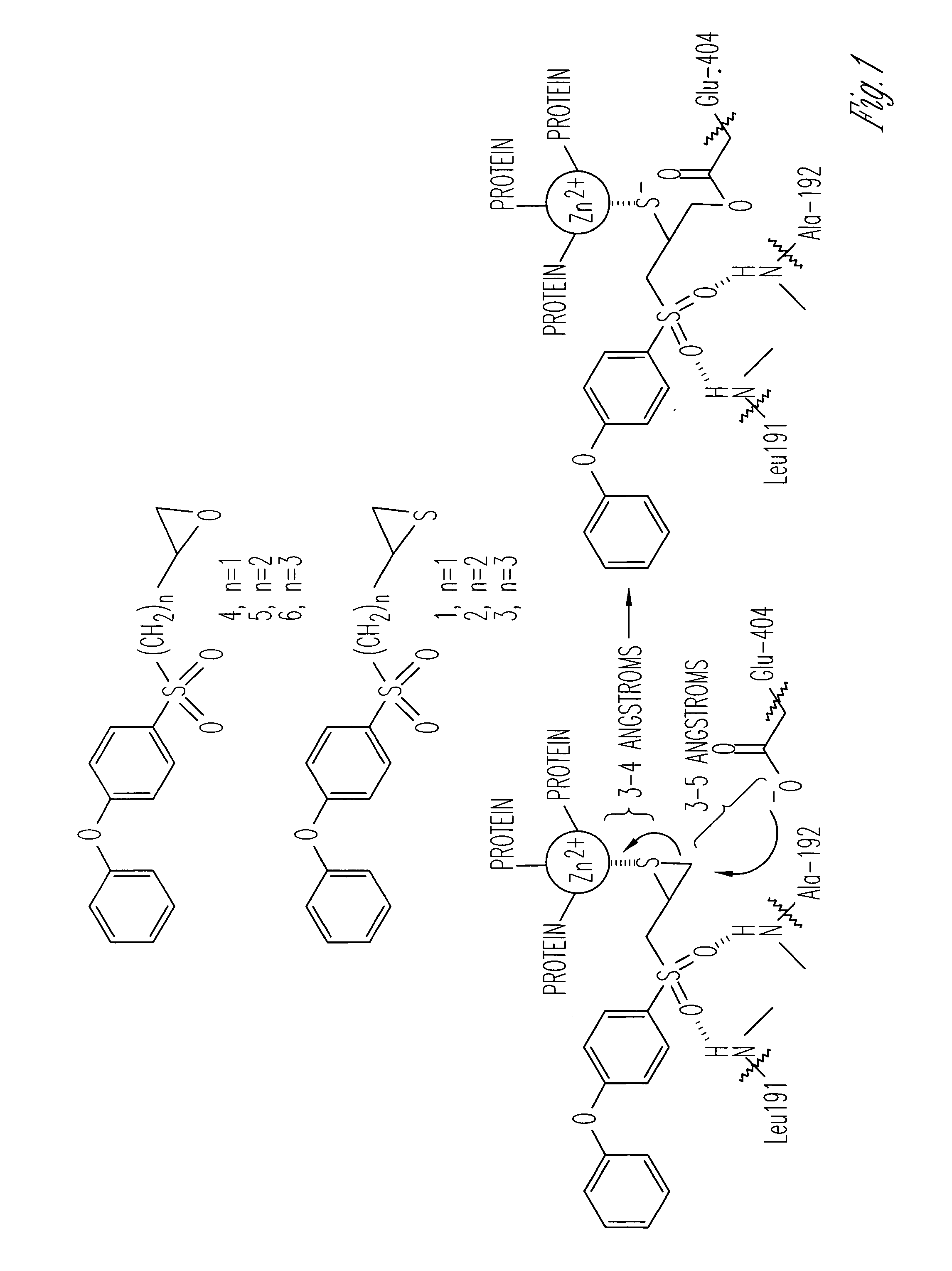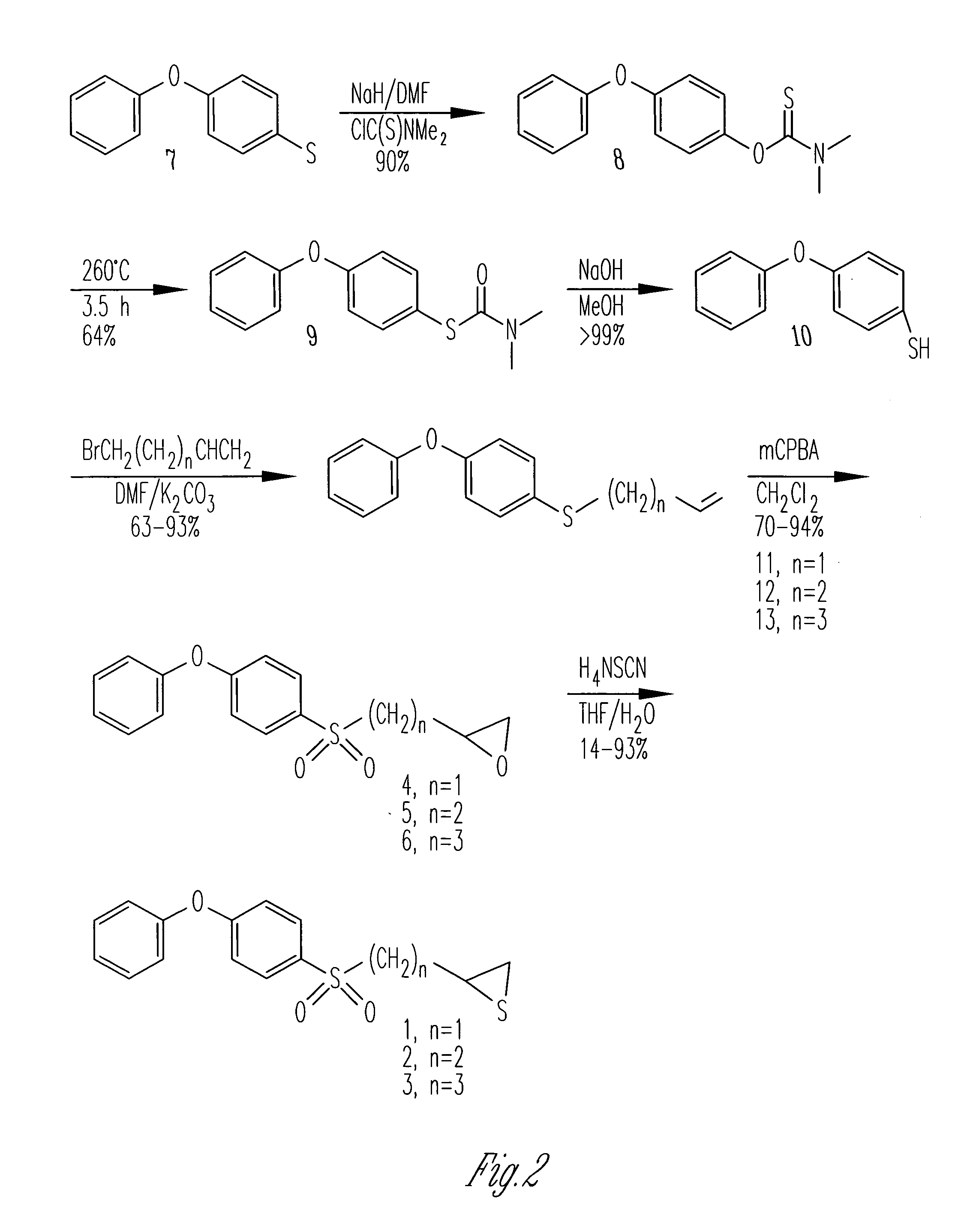Inhibitors of matrix metalloproteinases
a technology of matrix metalloproteinases and inhibitors, which is applied in the direction of heterocyclic compound active ingredients, biocide, drug compositions, etc., can solve the problems of increasing the risk of mortality tenfold or more, and the inhibitors of mmps are often toxic to the host, so as to prevent ovulation and prevent implantation
- Summary
- Abstract
- Description
- Claims
- Application Information
AI Technical Summary
Benefits of technology
Problems solved by technology
Method used
Image
Examples
example 1
[0169](4-Phenoxyphenylsulfonyl)methyloxirane (4). To compound 11 (598 mg, 2.5 mmol) in dichloromethane (10 mL), mCPBA (2.84 g, 10 mmol, Aldrich 57–86%), was slowly added. The mixture was stirred at room temperature for 3 days, after which time a second portion of mCPBA (2.84 g, 10 mmol) was added. The mixture was then stirred for another 4 days, after which time the mixture was poured into ethyl acetate (200 mL), and washed with aqueous sodium thiosulfate (3×50 mL, 10% w / v), aqueous sodium bicarbonate (3×50 ml, 5% w / v), and brine (50 ml). The organic phase was dried over magnesium sulfate and was concentrated to provide a yellow oil. The crude material was purified by column chromatography (silica, 4:1 hexanes:ethyl acetate) to give compound 4 as a pale yellow semi-solid (501 mg, 70%). 1H NMR (500 MHz, CDCl3) d 7.90–7.86 (m, 2 H), 7.46–7.40 (m, 2 H), 7.26–7.22 (m, 1 H), 7.10–6.96 (m, 4 H), 3.34–3.24 (m, 2 H), 2.84–2.8 (m, 1 H), 2.49–2.46 (m, 1 H); 13C NMR (125 MHz, CDCl3) d 163.15, ...
example 2
[0175]2-(4-Phenoxyphenylsulfonyl)ethyloxirane (5). The title compound was prepared in the same manner as described for 4, with the exception that compound 12 was used in place of compound 11, and the reaction time was 2 days. The title compound was obtained as a white solid (78%). m.p. 75–77 CC; 1H NMR (500 MHz, CDCl3) d 7.84–7.80 (m, 2 H), 7.44–7.38 (m, 2 H), 7.24–7.20 (m, 1 H), 7.09–7.04 (m, 4 H), 3.25–3.15 (m, 2 H), 3.02–2.97 (m, 1 H), 2.76 (t, J=4.3 Hz, 1 H), 2.49 (dd, J=3.0 and 5.0 Hz, 1 H), 2.19–2.10 (m, 1 H), 1.86 (m, 1 H); 13C NMR (125 MHz, CDCl3) d 162.93, 155.02, 130.58, 130.81, 125.47, 120.69, 117.91, 53.15, 50.32, 47.29, 26.23; IR(KBr disc) 3040 (s), 1580 (s), 1490 (s), 1320 (s), 1248 (s), 1148 cm−1; m / z (EI) 304 (M+, 80%), 233 (50), 217 (100); HRMS (EI) calcd. for C16H16O4S 304.0769, found 304.0768.
[0176](A.) 4-(4-Phenoxyphenylsulfanyl)-1-butene (12). The title compound was prepared in the same manner as described for 11, with the exception that 4-bromo-1-butene was use...
example 3
[0177]3-(4-Phenoxyphenylsulfonyl)propyloxirane (6). The title compound was prepared in the same manner as described for 4, with the exception that compound 13 was used in place of compound 11, and that the reaction time was 3 days. The title compound was obtained as a white solid (94%). 1H NMR (500 MHz, CDCl3) d 7.86–7.80 (m, 2 H), 7.44–7.39 (m, 2 H), 7.25–7.22 (m, 1 H), 7.10–7.04 (m, 4 H), 3.21–3.08 (m, 2 H), 2.90–2.86 (m, 1 H), 2.74 (t, J=4.5 Hz, 1 H), 2.45 (dd, J=2.5 and 4.5 Hz 1 H), 1.92 (quin, J=7.0 Hz, 2 H), 1.85–1.78 (m, 1 H), (m, 1 H); 13C NMR (125 MHz, CDCl3) d 162.84, 155.08, 130.58, 130.48, 125.43, 120.70, 117.88, 56.28, 51.64, 46.86, 31.17, 20.12; IR(KBr disc) 3063 (w), 2923 (w), 1582 (s), 1488 (s), 1294 (s), 1246 (s), 1142 (s) cm−1; m / z (EI) 318 (M+, 40%), 290 (20), 217 (100%); HRMS (EI) calcd. for C17H18O4S 318.0926, found 318.0924.
[0178](A.) 5-(4-Phenoxyphenylsulfanyl)-1-pentene (13). The title compound was prepared in the same manner as described for 11, with the exc...
PUM
| Property | Measurement | Unit |
|---|---|---|
| excitation wavelengths | aaaaa | aaaaa |
| excitation wavelengths | aaaaa | aaaaa |
| excitation wavelengths | aaaaa | aaaaa |
Abstract
Description
Claims
Application Information
 Login to View More
Login to View More - R&D
- Intellectual Property
- Life Sciences
- Materials
- Tech Scout
- Unparalleled Data Quality
- Higher Quality Content
- 60% Fewer Hallucinations
Browse by: Latest US Patents, China's latest patents, Technical Efficacy Thesaurus, Application Domain, Technology Topic, Popular Technical Reports.
© 2025 PatSnap. All rights reserved.Legal|Privacy policy|Modern Slavery Act Transparency Statement|Sitemap|About US| Contact US: help@patsnap.com



